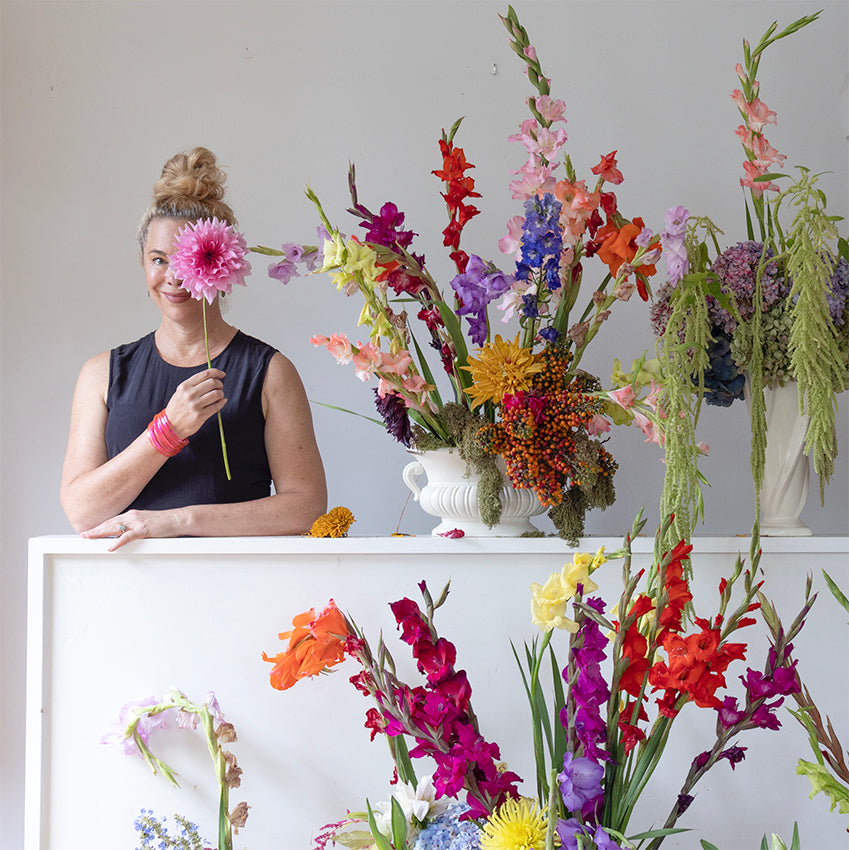My vase collection !
September 29, 2019
Read all about my obsession in Homed Stuff HERE

The language of flowers is artist Emma Bass' second tongue.
More than merely proficient, her floral portraits are fluent in the seductive vocabulary of petal, leaf and stem, creating luscious, seductive, striking compositions that deliver a sharp bite of reality. In a world obsessed with perfection, these images of flora "on the turn" explore the nature of beauty and its relationship with decline and demise, like a modern take on Renaissance memento mori and Romantic still lifes.
Anchoring each image is always a vase from Bass' extensive collection, usually one that gives her frothy floral designs a run for their money in terms of texture, movement and colour.
"The vases are an important part of my work as they are vessels. Vessels are containers that hold something… in this case the flowers. I sometimes see them as metaphors for us and our bodies, with the flowers symbolising the life that goes on around us.
I have an instinctive, exacting eye for collecting the vases. I collect vases that I respond to from an aesthetic perspective… it's a very intuitive thing. I started off collecting New Zealand-made Crown Lynn ones, but I now search for interesting pieces worldwide. I collect vases which are mostly ceramic, pottery, with a bit of porcelain"

Do you consider yourself a collector, or a connoisseur?
A collector is someone who collects objects because they are beautiful, valuable, or interesting. A connoisseur is an expert; especially one who understands the details, technique, or principles of an art. An aficionado is someone who is very interested in and enthusiastic about a particular subject.
I am definitely more of a collector and also an aficionado, as this is something I am very enthusiastic about. I find the gathering of objects/vases requires a discipline, some knowledge and an eye for the unusual or particularly beautiful. I love the process of searching online as there is such a vast sea of vases all over the world.
I collect the vases as I find them, and I'm very interested in the sense of history as well as enthusiastic about the huge range of shapes.
I love the fact that these vases have all had an unknown life, and often wonder what sorts of owners and homes they've had. They will all have stories to tell. I don't have a hugely detailed knowledge about the vases, but I am learning as I collect from different eras and parts of the world.

How do you like to use them – do you start with a vase in mind and style the flowers accordingly, or start with a bouquet or particular flower and go from there?
My floral creations are very much a combination of the vase and the flowers. They both work together to create the final work. Sometimes the vase determines the outcome, or the flowers will.
I may come across an incredible vase and wait for the right flower combination to emerge, which can take some time, as I'll have a particular flora in mind that might not be around until a certain time of the year. Or I will come across some floral matter that I have to work with then and there before it perishes, and will find the right vase to complement it. It's a bit like arranging a marriage. Sometimes I'll have a vase and ponder for a long time before it becomes apparent what should be photographed in it.

Tell us about the piece that kicked off the collection.
My first vase was a Crown Lynn vase. I was drawn to it in a second hand shop on Ponsonby Rd. I now have 225. They are an international selection from all around the world. I have had to slow down somewhat as I can barely fit them in my house now. One of the drawbacks of living in a 1950s house is there are a lot of windows and less wall space for displaying art and vases!
I love Beswick, Sylvac, Spode, and Shorter & Son from the UK; and Haeger, McCoy and American Art Pottery from the USA. I have started a Japanese assemblage, and also one of Delft vases.

Do you have a favourite piece, if so what is it that appeals to you?
Oh, I have so many favourites. One favourite is a 1950s Royal Haeger vase from the USA. It is a magnificent, large beauty which I have never seen another of. It arrived damaged but luckily it was salvageable, and I taught myself how to kintsugi – the Japanese art of repair with gold. The vase resonates with me because of this imperfection.

I many other favourites: two feather vases, a blue and a white – also by Haeger – which almost look like a wave. The shape of these is exquisitely poetic. There's my antique Delft vase collection, my flamingo vases...

A heart vase from New York stopped me in my tracks when I spied it online. I had grown up around hearts, with my father being a cardiologist, and I was once a nurse working in a cardiothoracic intensive care unit. Hearts are another universal symbol, as well as flowers, that resonate with me.

A lot of the pieces seem to be white or very pale. Is it the colour itself that appeals, or because it's a blank canvas for your work?
I mostly have white or cream pieces as I love the simple form that allows the flowers to work within them. I have started collecting more complex vases with colour and detailing, such as Delft blue and white vases, and also more Rococo embellished vases. I love the Italian style of Capodimonte, which is a porcelain vase with intricate decorative flowers moulded to the outside.

You buy a lot of your pieces online – can you tell me about the "one that got away"?
I mostly buy from eBay. I rarely let them get away – I have a competitive side to me.
How important is the cost of the piece to you?
If I fall in love with a piece, I will pay as much as I need to add it to my collection. Mostly I keep it reasonable and usually go for ones I can make an offer on. Shipping is always an issue, and sometimes it costs more to ship than to buy the vase! I have ongoing guilt that this is not a great habit for the environment.

What are your tips for choosing a vintage vase?
I think act on your gut and choose something that you connect with or find beautiful. This is a very subjective thing, of course.You could also find a type that you like and build up a collection around that – such as only Crown Lynn, Beswick, Sylvac etc. It's always interesting to see all the different forms that can come out of one manufacturer.

What are your online auction tips?
I rarely do the auctioned items as they can get a bit out of hand and my competitive spirit can end up fleecing me. I usually go for "buy now" items, and it's good if you can make an offer as you can often get it at a lesser price than it's listed for. I also look for the cheapest shipping option.
Also, when you're collecting in large volumes, you have to accept that there will be some breakages – I've only had four or five breakages and most of those I've been able to repair with kintsugi.

Also in News
Yes! I would like to receive news from Emma Bass





